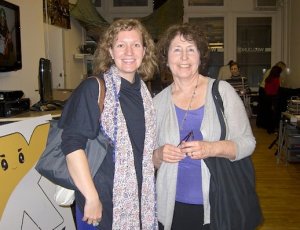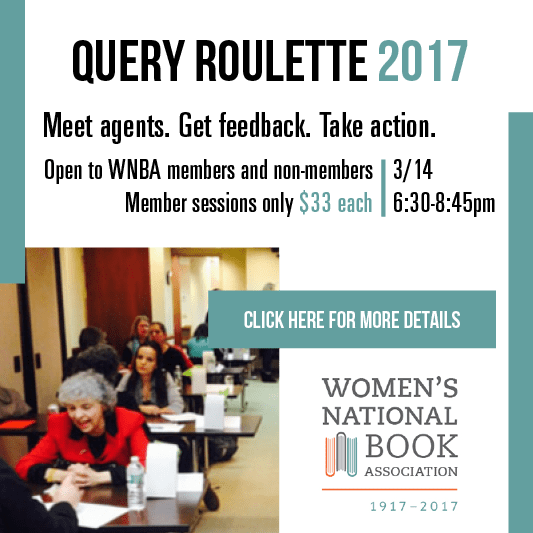By Sonia Kane
 On the evening of April 26th, it was standing room only at Wix Lounge for WNBA-NYC’s panel discussion on the popular topic of historical fiction. The five panel members included literary agent Daniel Lazar (Writers House), editor Heather Lazare (Touchstone/Simon & Schuster), editor and reviewer Barbara Hoffert (Library Journal), and two authors of recent works of historical fiction, Carole DeSanti (The Unruly Passions of Eugenie R.), and Kathryn Harrison (Enchantments). DeSanti, who is Vice President, Editor at Large at Viking Penguin, contributed insights not only as an author but as a longtime publisher. WNBA-NYC’s Rosalind Reisner moderated the panel.
On the evening of April 26th, it was standing room only at Wix Lounge for WNBA-NYC’s panel discussion on the popular topic of historical fiction. The five panel members included literary agent Daniel Lazar (Writers House), editor Heather Lazare (Touchstone/Simon & Schuster), editor and reviewer Barbara Hoffert (Library Journal), and two authors of recent works of historical fiction, Carole DeSanti (The Unruly Passions of Eugenie R.), and Kathryn Harrison (Enchantments). DeSanti, who is Vice President, Editor at Large at Viking Penguin, contributed insights not only as an author but as a longtime publisher. WNBA-NYC’s Rosalind Reisner moderated the panel.
Reisner began with a question: What is historical fiction? Does it have to take place at least 60 years before the current period, as in Walter Scott’s Waverley, generally considered the first historical novel in English? Daniel Lazar noted that he considered anything set during and before World War II to fit the bill; Heather Lazare agreed that this was an appropriate benchmark, but said that a lot depends on how a book is packaged by an agent and what audience a publisher is trying to reach: “From a publisher’s standpoint, are we going after the historical fiction bloggers? The mommy bloggers?” Panelists generally agreed that whereas historical novels used to be considered strictly genre fiction, with plots featuring either romance or, as Barbara Hoffert memorably put it, “sweaty men sticking things into each other,” today’s historical novels are often more accurately labeled as literary fiction, as in the case of the phenomenally successful Wolf Hall, by Hilary Mantel, which won the Man Booker and National Book Critics Circle Award. For a book review editor like Hoffert, this shift can make assigning books to the appropriate reviewers more perplexing, but she still is in favor of broadening categories to reach as many readers as possible, and has even at times used the seemingly contradictory label “literary/popular.” DeSanti echoed this thought: “Writers are working to broaden what historical fiction can be. . . . today the trend is toward hybridity, depth, and character-driven novels.”
 Harrison and DeSanti shared brief descriptions of their novels: Enchantments, set during the Russian Revolution, is told by Masha, daughter of the monk Rasputin. A woman whom Harrison found to be a “strangely modern character,” Masha escaped the Bolsheviks, survived a marriage with a husband chosen for her by her father, and eventually had a successful career as a lion tamer! DeSanti’s work, set in France during the Second Empire (1860-1871), focuses on a young woman who leaves her home in the provinces to meet her lover in Paris. Pregnant and alone, she waits for him in vain. DeSanti described her protagonist as “on a path to finding her center . . . in a polarized culture that was both hedonistic and moralistic.” She sees Eugenie’s story as one of “becoming alienated from what you love and desire and then finding your own way back,” adding that her book might be considered “self-help folded into historical fiction.”
Harrison and DeSanti shared brief descriptions of their novels: Enchantments, set during the Russian Revolution, is told by Masha, daughter of the monk Rasputin. A woman whom Harrison found to be a “strangely modern character,” Masha escaped the Bolsheviks, survived a marriage with a husband chosen for her by her father, and eventually had a successful career as a lion tamer! DeSanti’s work, set in France during the Second Empire (1860-1871), focuses on a young woman who leaves her home in the provinces to meet her lover in Paris. Pregnant and alone, she waits for him in vain. DeSanti described her protagonist as “on a path to finding her center . . . in a polarized culture that was both hedonistic and moralistic.” She sees Eugenie’s story as one of “becoming alienated from what you love and desire and then finding your own way back,” adding that her book might be considered “self-help folded into historical fiction.”
Both authors spoke of their delight in giving voice to their characters. In Harrison’s novel, the protagonist is a real woman whose remarkable story had yet to be told. In DeSanti’s work, she is a type—courtesan—who recurs in the fiction of male writers of the nineteenth century, and yet whose thoughts are not often explored by those writers. As she put it, “Zola does not give Nana an interior history.” Harrison and DeSanti also spoke of the immense and consuming pleasures of research—as well as its perils. DeSanti noted that she “used artifacts to get the emotion of the time,” artifacts such as ration cards, dancing slippers, and even a piece of bread perfectly preserved from the Siege of Paris. She became so immersed in the period that her friends were worried, asking her, “Are you ever going to leave the nineteenth century?” Harrison pointed out the danger for historical novelists of trying to “jam things in” to their novels, just to put their research to work. “You will use three to five percent of what you have taught yourself; it’s important for a historical novelist to be disciplined.”
The evening concluded with a robust question-and-answer session in which the authors provided further details about their research methods (DeSanti noting that she had read “an entire dictionary of smutty French words from the nineteenth century”) and literary agent Lazar gave tips on how to write a good query letter (“be very specific and evocative, give us a taste of the atmosphere of your novel”). Afterward, audience members milled about happily and got their newly purchased books signed. Ashley Gallman and Omri Arad of Wix Lounge were enormously competent and convivial hosts, as always; many thanks to them for their enthusiasm and good cheer. For the hosts, the panelists, and the audience, it was clear that historical fiction remains an enduring genre.
 Sonia Kane is a free-lance editor and writer living in Brooklyn. Formerly Assistant Director of Book Publications at the Modern Language Association, she has a PhD in English from the CUNY Graduate Center and teaches literature and writing at Hunter College. She has recently been appointed Co-Editor of the NY Bookwoman, the official newsletter of the NY chapter of the Women’s National Book Association.
Sonia Kane is a free-lance editor and writer living in Brooklyn. Formerly Assistant Director of Book Publications at the Modern Language Association, she has a PhD in English from the CUNY Graduate Center and teaches literature and writing at Hunter College. She has recently been appointed Co-Editor of the NY Bookwoman, the official newsletter of the NY chapter of the Women’s National Book Association.





Great report! It really captures the mood of the evening!
Terrific post — made me wish I was there. I particularly liked the insight of reading an entire dictionary of smutty French words — I’m looking forward to reading that novel! Voila! Truly, the author of LIE.
Pingback: Historical Fiction in the Making « Women's National Book Association – NYC
Pingback: Historical Fiction trying not to lie « Hey – Who Wrote That?